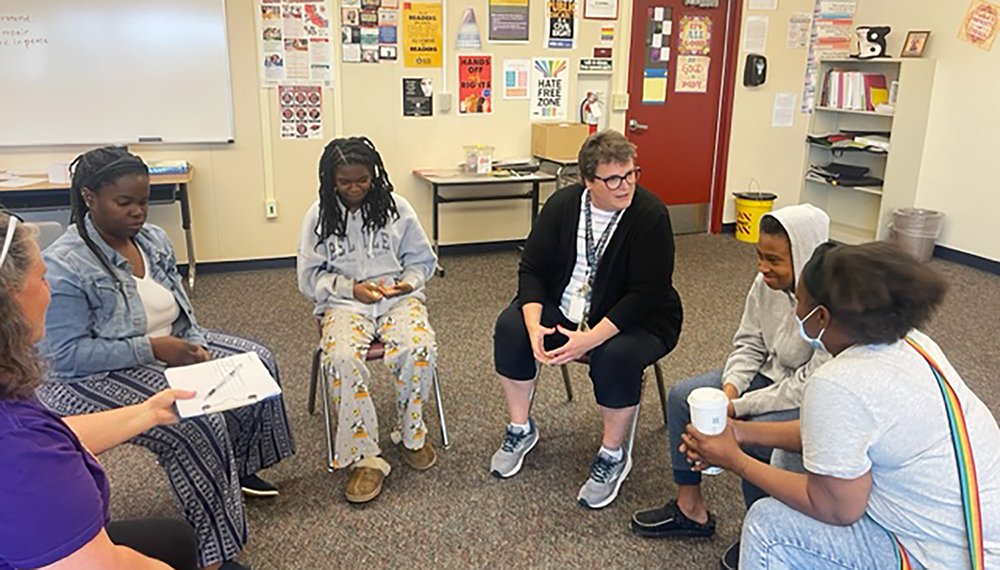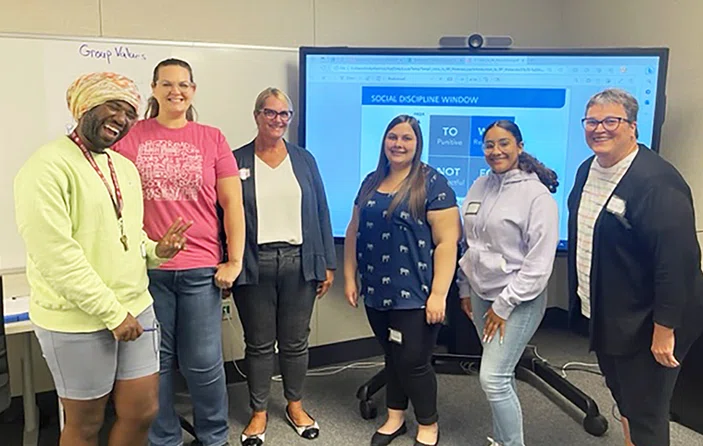
Deb Hubbard, third from left, leads a circle at Antioch Middle School. Antioch USD has recently expanded its restorative practice program to include seven site-based restorative facilitators.
In Antioch, restorative practices are a districtwide mindset
October 16, 2023
The following article was written by Lindsay Lopez-Wisely.
The Antioch Unified School District has expanded its restorative practice program to include seven site-based restorative facilitators. The district also has a centralized teacher on special assignment who is helping to support the work. Data from 2015 through 2023 is showing a significant decline in suspensions and expulsions for all subgroups, and the stakeholder survey data shows a 4.6 out of 5 satisfaction level for parents, students, staff and administration. Stephanie Anello, superintendent for AUSD, started expanding restorative practices at the beginning of her tenure eight years ago. She led the implementation of site-based programs at Dallas Ranch Middle School and Antioch Middle School. In 2021 after the pandemic closure of schools, she saw the need to expand and centralize the program at the district office to broaden the support for students, parents and staff.
The start of this school year saw growth in the program again as the decision was made to blend both the site-based and centralized models into a comprehensive districtwide restorative vision. In addition, the Wellness Culture Climate Team (WCCT) is driving a multi-pronged approach to social-emotional support for all students, which includes a comprehensive restorative practice program, trauma-informed training, social-emotional learning curriculum (K-8), wellness rooms districtwide and increased mental health clinicians. The WCCT includes Associate Superintendent of Educational Services (Christine Ibarra), the Director of Secondary Schools (Lindsay Wisely), the Director of Student Support Services (Tim Cooper), a trauma-informed consultant (Jennifer Lynn Whaley, Ph.D.) and a Teacher on Special Assignment (Kristy Martinez). Soon to join the team again is Deb Hubbard, retired district restorative practices facilitator for AUSD and one of two original pioneers of the work. Dave Neal, the other pioneer of restorative practices in AUSD, was one of the first staff members to be trained by the International Institute of Restorative Practices. He led the program at Dallas Ranch Middle School from 2014 through 2020. This prompted district leadership to also launch a site-based program at Antioch Middle School from 2015 to 2020, which was led by Deb Hubbard.
The Dallas Ranch and Antioch programs ran parallel to each other from 2015 through 2020.
Suspensions and fights declined significantly, and most importantly, parents began reporting via a post-circle survey that they felt the issues were getting resolved. Overall, the site-based program helped Dallas Ranch reduce suspensions by 23.1 percent and Antioch Middle School by 46.1 percent, when compared to the average several years prior to the program. Suspension occurrences and total days of suspension also declined for African American and Latino students. Moreover, the years prior to the restorative program averaged a much higher yearly expulsion rate when compared to the years with the site-based program. Interestingly, even the districtwide average began to decline with the implementation of both site-based programs.
“Antioch Unified School District is invested and committed to incorporating restorative practices districtwide in an effort to decrease suspensions and expulsion rates and increase equity and inclusion for all students.”
— Kristy Martinez, Restorative TOSA, Antioch USD
In the 2021-22 school year, the site-based facilitators were moved to the district office to expand the restorative practices program. They quickly began training both certificated and classified staff on restorative practices and community building. Post survey data shows 97 percent of staff found the training valuable. By 2023 the decision was made to provide both site and centralized restorative practices as a key component to the district’s vision to building healing and resilient centered schools with its core components centered around standards-based learning, culturally relevant pedagogy and healing (restorative and trauma informed).
With the combination of site-based facilitators and a centralized teacher on special assignment, the plan this school year is to expand training for all staff and conduct more conflict circles. Some of the highest stakes circles include parents, students, administrators and school staff. Strong facilitation skills are needed to resolve intense conflicts. When asked at the end of the circle via an anonymous survey to rate the circle’s effectiveness in resolving the conflicts, parents rated 4.83/5, students 4.59/5, staff 4.43/5, administrators 4.71/5. The circle success rate is notably positive. In a smaller scale survey at Antioch Middle School, staff were asked to rate the impact restorative practices had on their classroom environment, serious behavior issues, teacher stress level, classroom management, relationships amongst students and their retention, and all teachers surveyed said they agreed or strongly agreed that restorative practices had a positive impact on all of the categories.
The AUSD restorative training is comprehensive and starts with how to build community in the classroom, fair process and affective statements, and moves into the components of a restorative circle. Since the district expanded from a site-based model to a centralized model, the total number of circles declined at Antioch Middle School and Dallas Ranch Middle School. With only two facilitators in 2021–2023, the conflict circles that could be conducted had to be the highest stakes. As data showed the positive impact the program was having with students, parents, teachers, classified staff and administrators, it was determined that there was a strong need to blend the site-based and centralized models into seven facilitators and a centralized TOSA. This allows for the best of both worlds with the ability for site-based facilitators to train the staff and conduct circles with families at the school site, while the centralized facilitator monitors program fidelity and drives a larger vision for student support districtwide. Most notably, the district TOSA also trains the wellness room paraprofessionals, sets up data tracking for the restorative and wellness rooms, conducts professional learning communities for counselors and participates on grant writing projects.
This holistic vision has helped Antioch Unified be on the cutting edge of restorative work nationally. One of the lessons that can be learned from AUSD is the importance of leadership. The leadership of the facilitators, TOSA, principal and district administration is key to working in concert to drive a vision districtwide. In AUSD, this is not another program but a mindset that helps our community build “Healing and Resilient Centered Schools.” We are proud of our students, parents, teachers, classified support staff and administrators for embracing this mindset.
“Antioch Unified School District is invested and committed to incorporating restorative practices districtwide in an effort to decrease suspensions and expulsion rates and increase equity and inclusion for all students,” said current restorative TOSA Kristy Martinez. “When it comes to restorative practices and public education, AUSD is an innovative and progressive leader.”
Lindsay Lopez-Wisely is director of Educational Services, Secondary Support, for Antioch Unified School District.

Restorative facilitators and members of the district’s Wellness Culture Climate Team set the tone for restorative practices in Antioch Unified School District.



